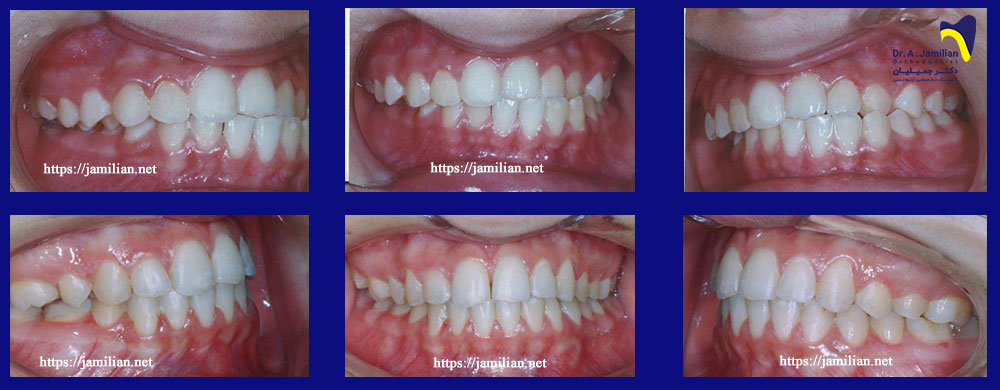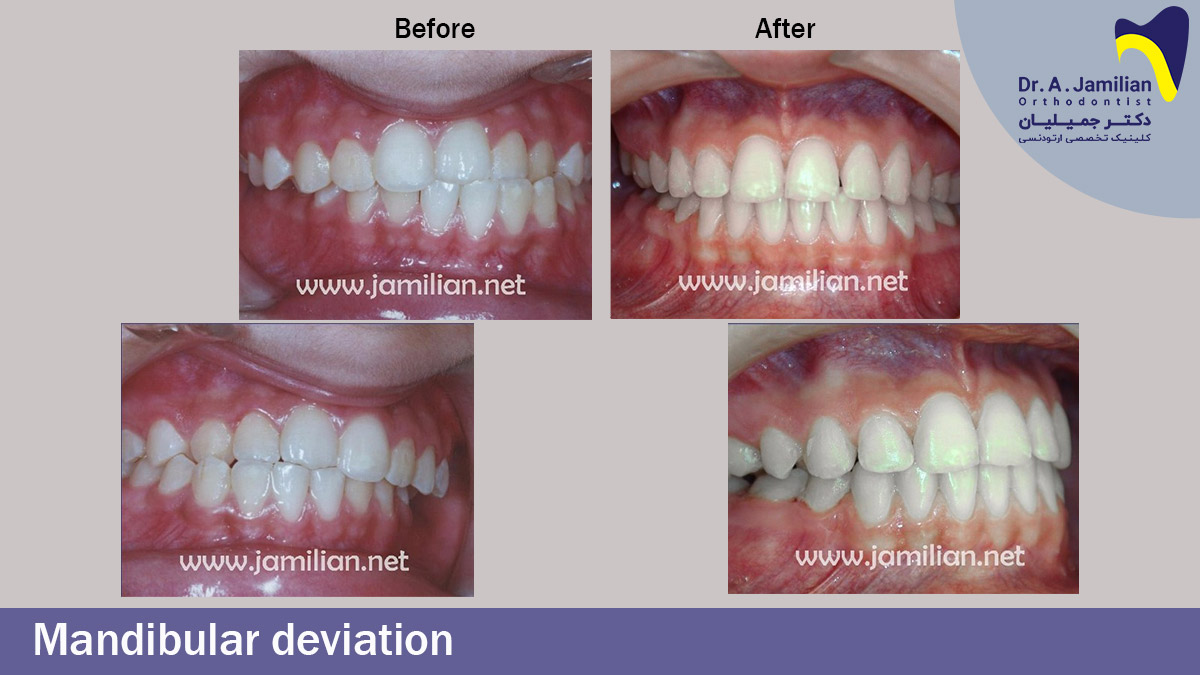As the name implies, mandibular deviation is a skeletal malformation in which the mandible is deviated to one side. Midline discrepancy can be clearly seen in this anomaly. Mandibular deviation can be congenital or acquired. In the acquired type, the jaw usually deviates to one side as a result of inappropriate fracture and fusion in childhood.

Weakness of one side of the face is another cause of mandibular deviation, where the jaw tilts to one side. mandibular deviation also occurs due to dental interference in the maxilla and mandible as well as untreated posterior cross bite. In some patients, TMJ enlarges in one side due to an unknown reason, resulting in jaw deviation or so-called hemimandibular hypertrophy.
Mandibular deviation treatment
If diagnosed at an early age, jaw deviation can be treated through orthodontics alone. However, orthodontic surgery may be required if treatment is performed at an older age, especially after puberty.
Treatment methods in childhood include the use of a hybrid functional appliance, posterior cross bite correction or early dental contact correction. If jaw deviation is due to hemimandibular hypertrophy, no treatment is performed and the TMJ is allowed to be grown until the growth ends, and then orthodontic surgery will be performed.
The following images show a patient with jaw deviation caused by maxillary and mandibular dental interferences.
The patient was referred at the age of 12 and surgical treatment was recommended due to an obvious jaw deviation. But only orthodontic treatment was performed because of disagreement of the patient with surgical intervention. The following images show the patient after orthodontic treatment. The following images show a patient with jaw deviation caused by maxillary and mandibular dental interferences.

The relation between orthodontics and jaw surgery
Generally, the objective of orthodontics could be divided into five categories: beautiful look, beautiful teeth, properly functioning teeth, better oral hygiene, and stability. Nonetheless, orthodontics alone may not be effective and sufficient to resolve malocclusion and jaw deformity in some cases.
In multiple cases of dento maxillary deformities, jaw surgery is required to resolve the problem of jaws based on the intensity of the problem. In such cases, either the patient is in an age range that dento maxillary structures cannot grow. Or, cannot be corrected, or the problem is so acute that orthodontic treatment is impossible or takes a lot of time.
Therefore, orthodontic treatment with jaw surgery is required to treat the dentofacial deformity of the patient. First, the teeth are positioned correctly by orthodontics and then, upper and lower jaws are proportioned by jaw surgery.
Jaw surgery or orthognathic surgery is performed by oral and maxillofacial surgeons and it corrects mild to acute skeletal problems in jaw bones including uneven jaw and teeth. It thus improves the function of teeth and mouth.
The stages of jaw deviation surgery and orthodontics
There is a close relation between orthodontics and jaw deviation surgery that together can give you a beautiful look. Using orthodontics with jaw deviation surgery needs 18 to 24 months for the best results. The stages of treatment are divided into four:
1-Planning treatment
The first step to treat dento maxillary deformities that cannot be resolved by orthodontics solely is planning the treatment. Initially, the patient’s problem, its root, and its intensity is determined. Next, treatment methods that can resolve the problem are presented. The intensity of the problem is determined through different tests and imaging when the patient has passed the development age.
The most important step in acute dento maxillary deformities is treatment planning since the treatment process cannot be changed or stopped when it has begun. Therefore, you and your dentist should act very deliberately planned.
2-Pre-surgery orthodontics
The orthodontics used to prepare for jaw surgery is different from common orthodontics. To achieve a beautiful look, you need proportionate teeth and jaws. The purpose of orthodontics before surgery is to create a proper condition of corrected teeth for jaw surgery. In fact, the arches of teeth in the jaws, how teeth are positioned, and the proportion of upper and lower teeth have to be set to some extent before jaw surgery. This helps determine the real intensity of jaw problems so that the surgeon can carry out the required corrections accordingly.
Different devices and methods are used to correct and reposition teeth and jaws. The required time in the end will be determined by the orthodontist, but in normal conditions initial correction of teeth takes about 12 to 18 months. The time will be indicated by malocclusions, related activities, and other factors.
3-Jaw surgery
Jaw deformities could cause numerous problems such as cosmetic, functional, digestive, respiratory, mental, and other problems. Jaw surgery or orthognathic surgery is an orthopedic surgery that is used to correct the structure and position of jaws.
Jaw surgery is considered as an invasive procedure and as a result, has different side effects such as inflammation, nasal and sinus congestion, and chewing and swallowing problems for several weeks. In this procedure, different changes, such as bone grafting or removal, are made to correct the size and structure of the jaw bone.
4-Post-surgery orthodontics
You need to visit your orthodontist about 4 or 6 weeks after the surgery to begin post-surgery orthodontic treatment. This short period of orthodontic treatment is required to correct minor deformities and stabilize the surgery. The purpose of this treatment period is to correct any dento maxillary deformities remaining from surgery.
It takes about 6 months and different orthodontic devices, particularly intermaxillary elastics, are used.
It should be noted that the more accurate and complete the pre-surgery orthodontics, the less time the post-surgery orthodontics require. When this treatment period ends, the patient should prepare her/himself to use retainers in order to preserve and stabilize the results of the surgery.






